Cities Where Women Outearn Their Husbands
Published on: 02/04/2021
While still the minority among married-couple households, wives who outearn their husbands have become much more commonplace. According to data from the Bureau of Labor Statistics, wives are the breadwinners in 29 percent of dual-income married couples.
Wives who earn more than their husbands were much more unusual 40 years ago. In 1981, just 15.9 percent of wives were breadwinners. By 2019, that figure had nearly doubled, but after years of mostly steady increases, the number of wives who outearn their husbands has plateaued. The COVID-19 pandemic has been especially challenging for working women, with many leaving the workforce or reducing their hours due to lack of childcare. Depending on how the effects of COVID-19 continue to impact families, the share of wives who are the primary breadwinners may look very different in the years ahead.
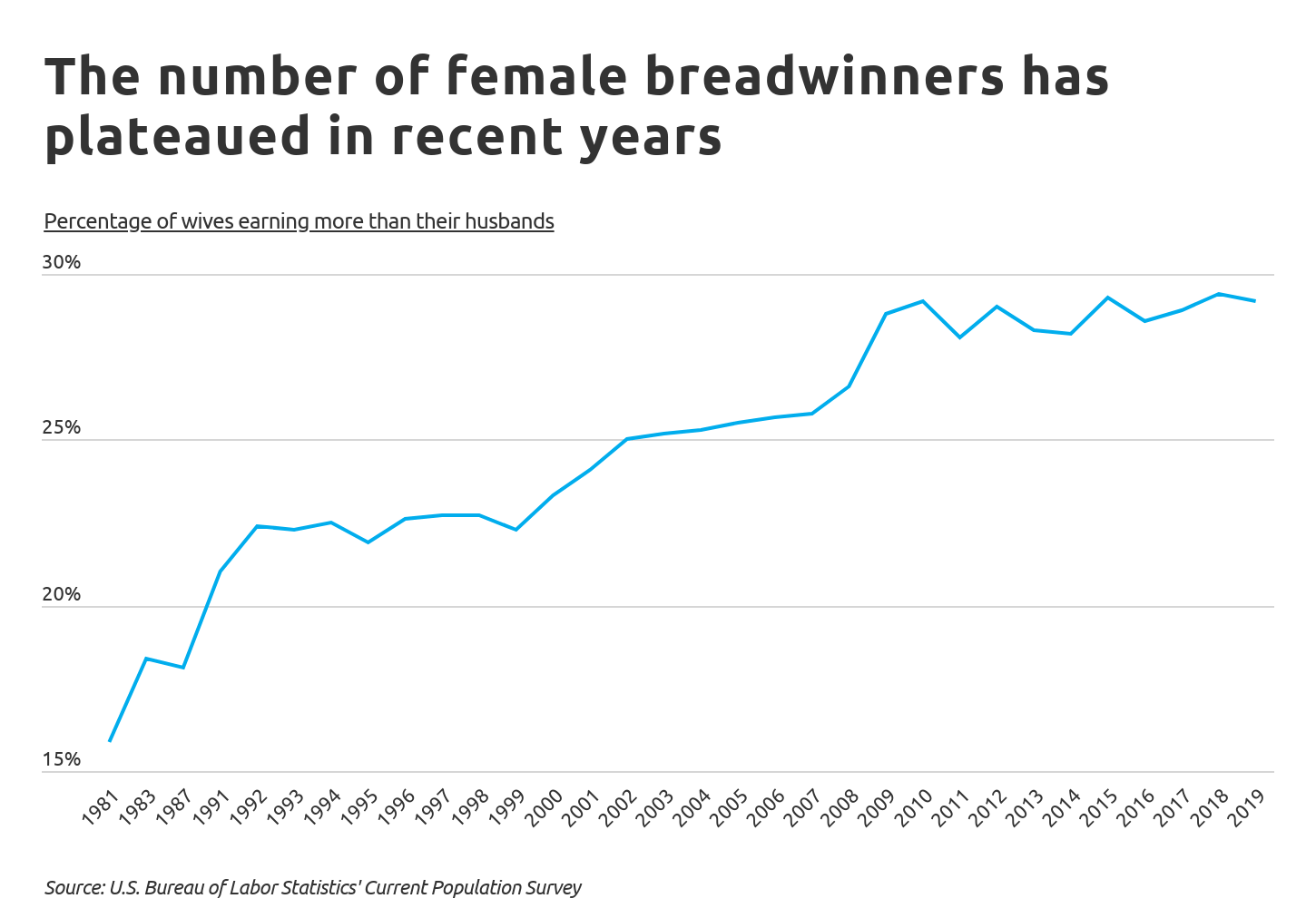
The earnings ratio—defined here as female earnings as a percentage of male earnings—among married couples varies considerably depending on their occupations. Husbands who outearn their wives by the largest margin tend to be in high-paying occupations, such as physicians or executives, whereas those who earn the least when compared to their partner are more likely to be in lower-paying occupations like teaching assistants or childcare workers.
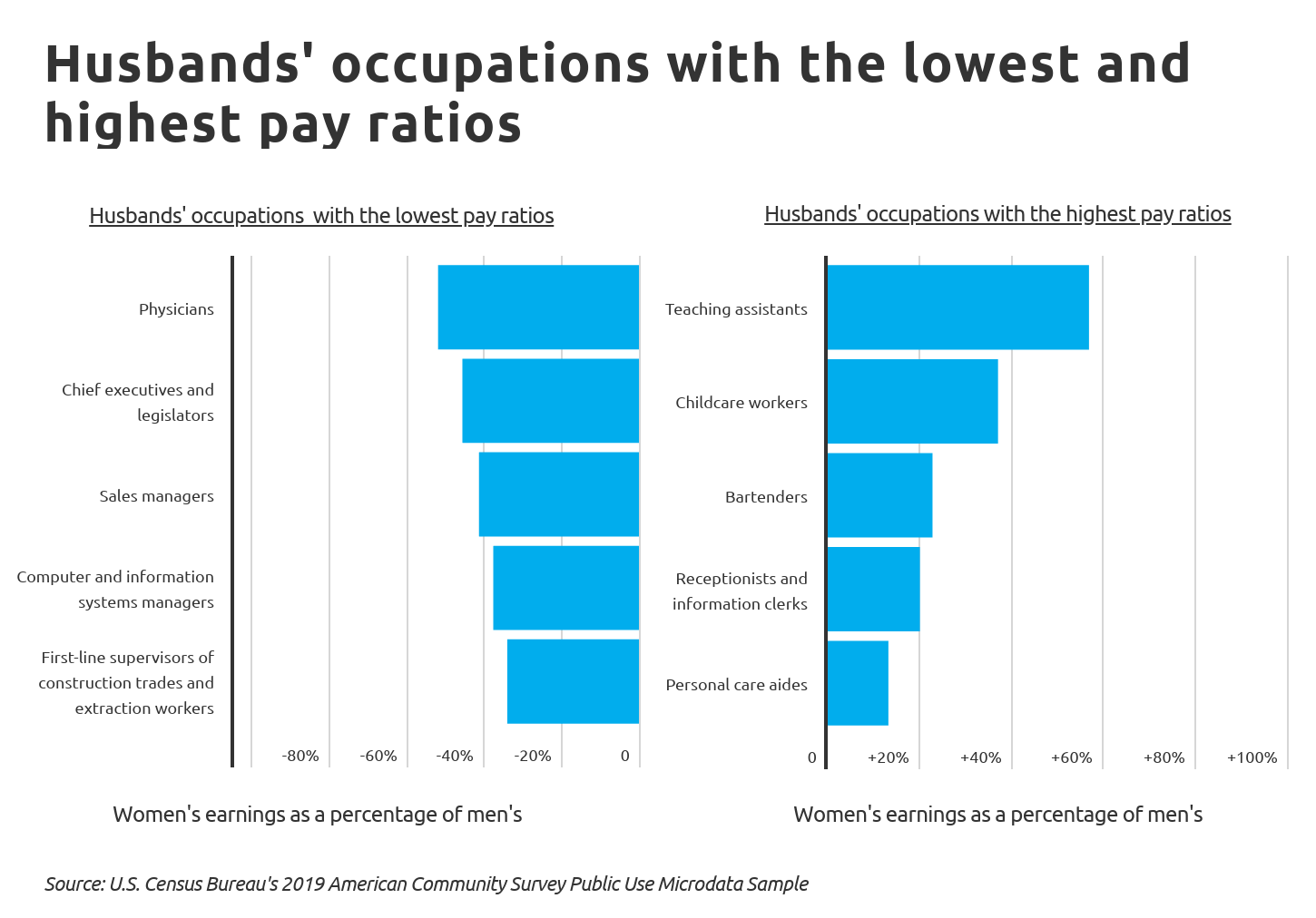
When considering the occupation of the wife, a similar set of jobs emerges. However, the difference in pay tends to be more extreme when the husband is the breadwinner than when the wife is the breadwinner. For example, while the wife of a male physician typically earns about half of what her husband earns, a female physician is expected to earn just 10 percent more than her husband.
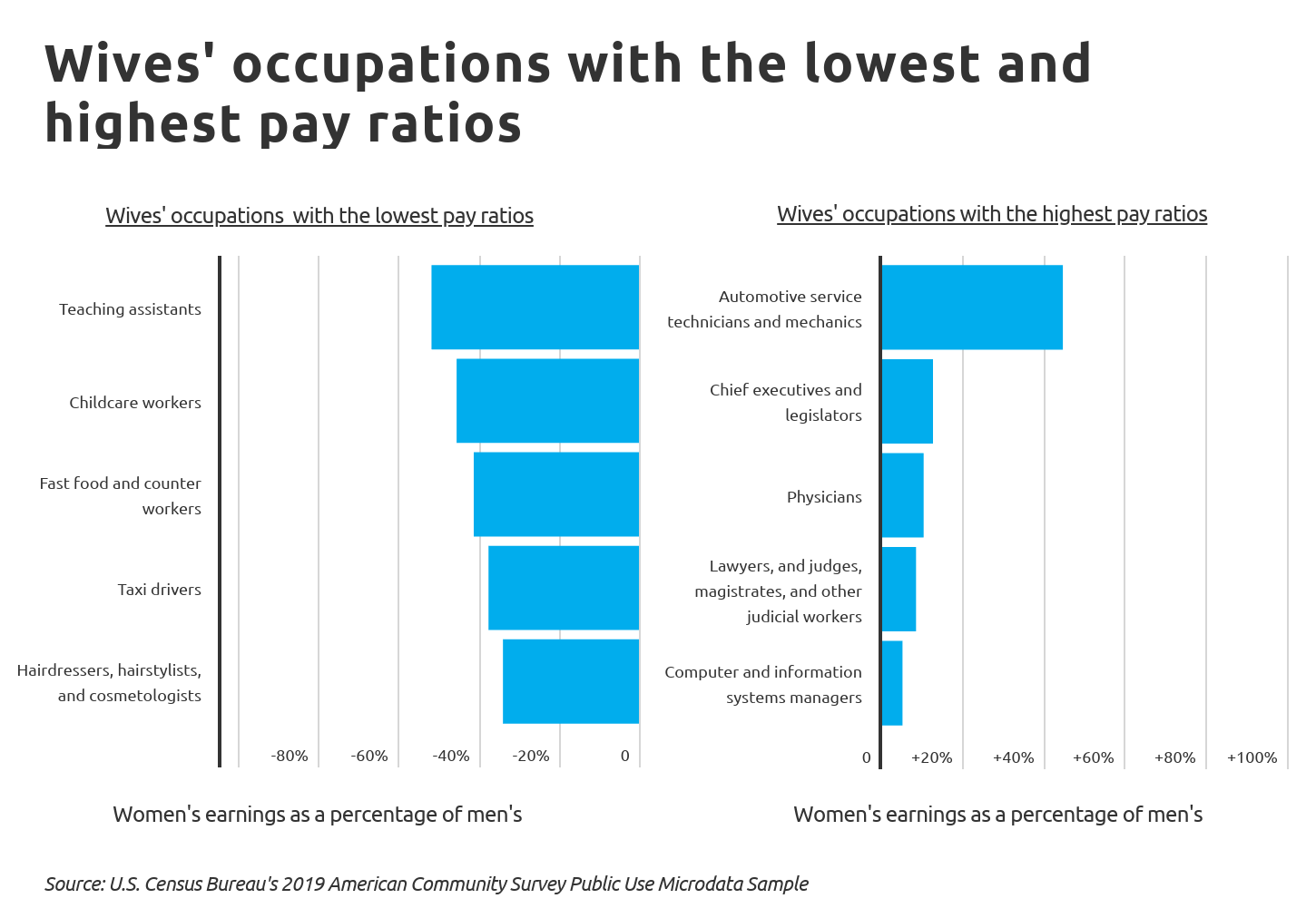
While wives are much more likely to outearn their husbands today than they were several decades ago, the share of female breadwinners varies on a geographic basis due to cultural and demographic differences. At the regional level, female breadwinners tend to be more common in the Northeast, where education levels are highest. Vermont and New York are home to the largest share of wives who outearn their husbands, at 36.2 and 32.9 percent, respectively. Utah and Idaho have the lowest percentages of wives who earn more than their husbands, at just 22.4 and 24.7 percent, respectively.
TRENDING
A prospective employer has the right to review your credit profile, but can you be denied a job because of bad credit?
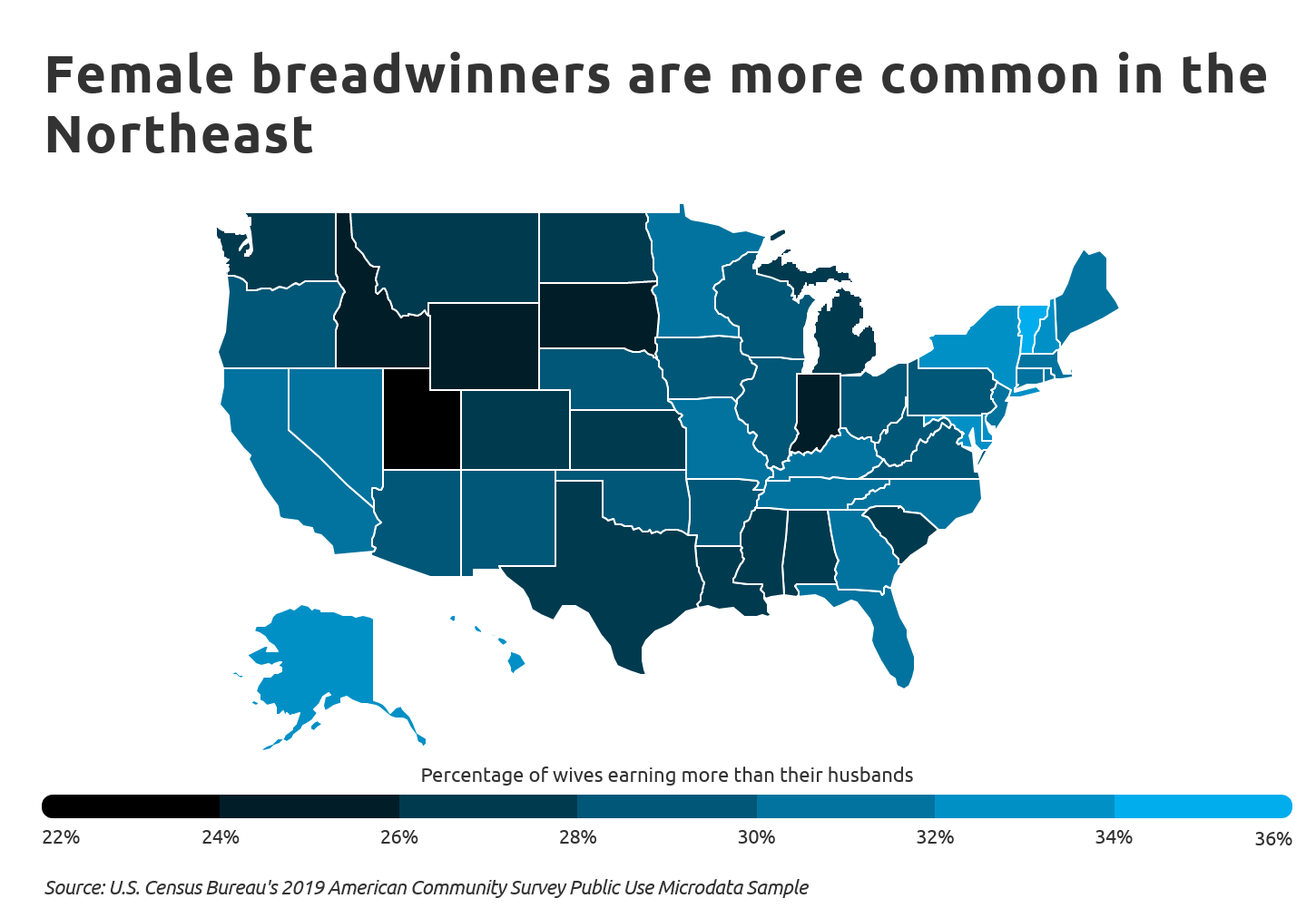
To find the metropolitan areas with the most female breadwinners, researchers at Self analyzed the latest data from the U.S. Census Bureau. The researchers ranked metro areas according to the percentage of wives earning more than their husbands. Researchers also calculated the median pay ratio for wives earning more than their husbands, median earnings for wives earning more than their husbands, the median pay ratio for all married women, and median earnings for all married women. The pay ratio is defined as women’s earnings as a percentage of men’s.
To improve relevance, only metropolitan areas with at least 100,000 people were included in the analysis. Additionally, metro areas were grouped into the following cohorts based on population size:
- Small metros: 100,000-349,999
- Midsize metros: 350,000-999,999
- Large metros: more than 1,000,000
Here are the metros with the most female breadwinners.
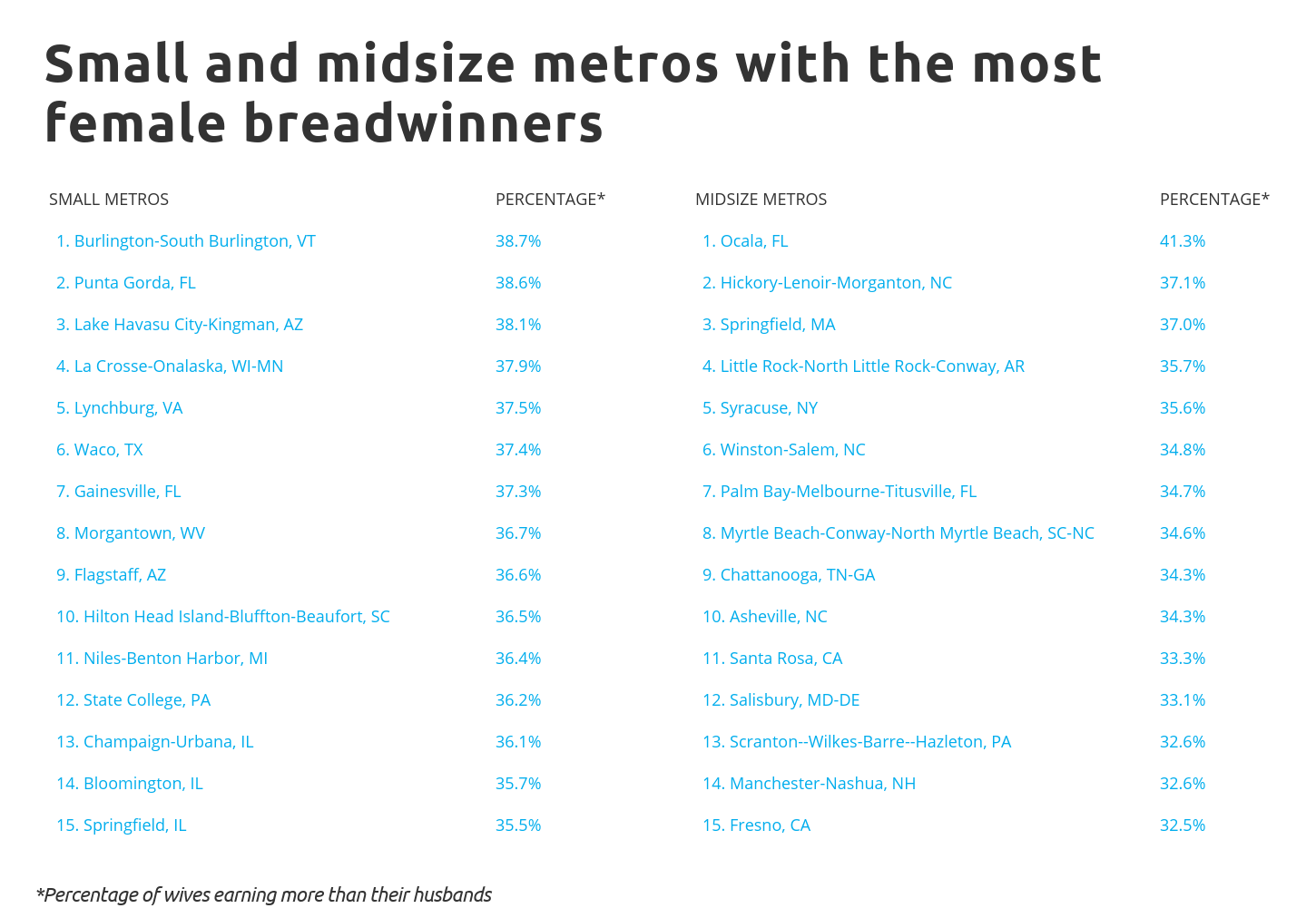
Large Metros With the Most Female Breadwinners

Photo Credit: Alamy Stock Photo
15. Las Vegas-Henderson-Paradise, NV
- Percentage of wives earning more than their husbands: 31.8%
- Median pay ratio for wives earning more than their husbands: +71.4%
- Median earnings for wives earning more than their husbands: $55,000
- Median pay ratio for all married women: -25.0%
- Median earnings for all married women: $37,700

Photo Credit: Alamy Stock Photo
14. Los Angeles-Long Beach-Anaheim, CA
- Percentage of wives earning more than their husbands: 31.8%
- Median pay ratio for wives earning more than their husbands: +68.0%
- Median earnings for wives earning more than their husbands: $71,000
- Median pay ratio for all married women: -27.4%
- Median earnings for all married women: $40,000
DID YOU KNOW?
A credit builder loan can help you build—or rebuild—your credit fast. Read our detailed guide to get started on the path to good credit.

Photo Credit: Alamy Stock Photo
13. Rochester, NY
- Percentage of wives earning more than their husbands: 32.0%
- Median pay ratio for wives earning more than their husbands: +53.8%
- Median earnings for wives earning more than their husbands: $65,000
- Median pay ratio for all married women: -25.0%
- Median earnings for all married women: $44,000

Photo Credit: Alamy Stock Photo
12. Memphis, TN-MS-AR
- Percentage of wives earning more than their husbands: 32.1%
- Median pay ratio for wives earning more than their husbands: +57.7%
- Median earnings for wives earning more than their husbands: $60,000
- Median pay ratio for all married women: -29.3%
- Median earnings for all married women: $40,000

Photo Credit: Alamy Stock Photo
11. Miami-Fort Lauderdale-West Palm Beach, FL
- Percentage of wives earning more than their husbands: 32.1%
- Median pay ratio for wives earning more than their husbands: +75.0%
- Median earnings for wives earning more than their husbands: $57,000
- Median pay ratio for all married women: -28.0%
- Median earnings for all married women: $35,000

Photo Credit: Alamy Stock Photo
10. San Antonio-New Braunfels, TX
- Percentage of wives earning more than their husbands: 32.2%
- Median pay ratio for wives earning more than their husbands: +65.9%
- Median earnings for wives earning more than their husbands: $60,000
- Median pay ratio for all married women: -25.3%
- Median earnings for all married women: $38,000

Photo Credit: Alamy Stock Photo
9. Philadelphia-Camden-Wilmington, PA-NJ-DE-MD
- Percentage of wives earning more than their husbands: 32.2%
- Median pay ratio for wives earning more than their husbands: +66.0%
- Median earnings for wives earning more than their husbands: $80,000
- Median pay ratio for all married women: -28.2%
- Median earnings for all married women: $50,000

Photo Credit: Alamy Stock Photo
8. New York-Newark-Jersey City, NY-NJ-PA
- Percentage of wives earning more than their husbands: 32.2%
- Median pay ratio for wives earning more than their husbands: +71.4%
- Median earnings for wives earning more than their husbands: $85,000
- Median pay ratio for all married women: -29.8%
- Median earnings for all married women: $50,000

Photo Credit: Alamy Stock Photo
7. Orlando-Kissimmee-Sanford, FL
- Percentage of wives earning more than their husbands: 32.5%
- Median pay ratio for wives earning more than their husbands: +58.8%
- Median earnings for wives earning more than their husbands: $55,000
- Median pay ratio for all married women: -25.7%
- Median earnings for all married women: $35,000

Photo Credit: Alamy Stock Photo
6. Oklahoma City, OK
- Percentage of wives earning more than their husbands: 32.7%
- Median pay ratio for wives earning more than their husbands: +51.2%
- Median earnings for wives earning more than their husbands: $60,000
- Median pay ratio for all married women: -29.7%
- Median earnings for all married women: $36,000

Photo Credit: Alamy Stock Photo
5. Nashville-Davidson--Murfreesboro--Franklin, TN
- Percentage of wives earning more than their husbands: 32.8%
- Median pay ratio for wives earning more than their husbands: +58.2%
- Median earnings for wives earning more than their husbands: $60,000
- Median pay ratio for all married women: -26.6%
- Median earnings for all married women: $40,000

Photo Credit: Alamy Stock Photo
4. Baltimore-Columbia-Towson, MD
- Percentage of wives earning more than their husbands: 32.8%
- Median pay ratio for wives earning more than their husbands: +59.6%
- Median earnings for wives earning more than their husbands: $86,000
- Median pay ratio for all married women: -26.7%
- Median earnings for all married women: $55,000

Photo Credit: Alamy Stock Photo
3. Richmond, VA
- Percentage of wives earning more than their husbands: 32.9%
- Median pay ratio for wives earning more than their husbands: +63.2%
- Median earnings for wives earning more than their husbands: $74,000
- Median pay ratio for all married women: -26.7%
- Median earnings for all married women: $45,000
TRENDING
We know—you need good credit to build your credit score, but you need a good credit score to build your credit. Learn how to build credit.

Photo Credit: Alamy Stock Photo
2. Minneapolis-St. Paul-Bloomington, MN-WI
- Percentage of wives earning more than their husbands: 32.9%
- Median pay ratio for wives earning more than their husbands: +58.3%
- Median earnings for wives earning more than their husbands: $76,000
- Median pay ratio for all married women: -26.7%
- Median earnings for all married women: $49,500

Photo Credit: Alamy Stock Photo
1. Tampa-St. Petersburg-Clearwater, FL
- Percentage of wives earning more than their husbands: 34.0%
- Median pay ratio for wives earning more than their husbands: +63.0%
- Median earnings for wives earning more than their husbands: $60,000
- Median pay ratio for all married women: -24.4%
- Median earnings for all married women: $40,000
Detailed Findings & Methodology
To find the metros with the most female breadwinners, researchers analyzed the latest data from the U.S. Census Bureau’s 2019 American Community Survey Public Use Microdata Sample. The researchers ranked metro areas according to the percentage of wives earning more than their husbands. In the event of a tie, the metro with the larger number of female breadwinners was ranked higher. Researchers also calculated the median pay ratio for wives earning more than their husbands, median earnings for wives earning more than their husbands, the median pay ratio for all married women, and median earnings for all married women. Only opposite-sex, dual-income married couples were included in the analysis.
Additionally, metros were grouped into the following cohorts based on population size:
- Small metros: 100,000–349,999
- Midsize metros: 350,000–999,999
- Large metros: 1,000,000 or more
About the author
Lauren Bringle is an Accredited Financial Counselor® with Self Financial – a financial technology company with a mission to increase economic inclusion by helping people build credit and savings. Connect with her on Linkedin or Twitter.
